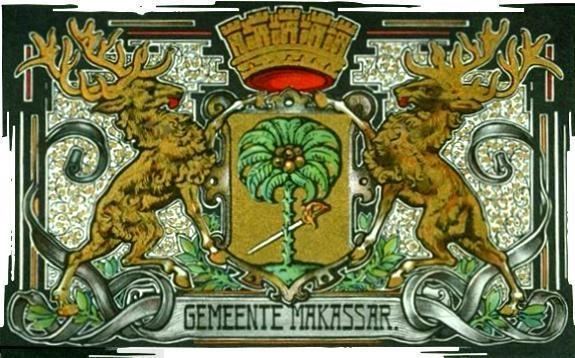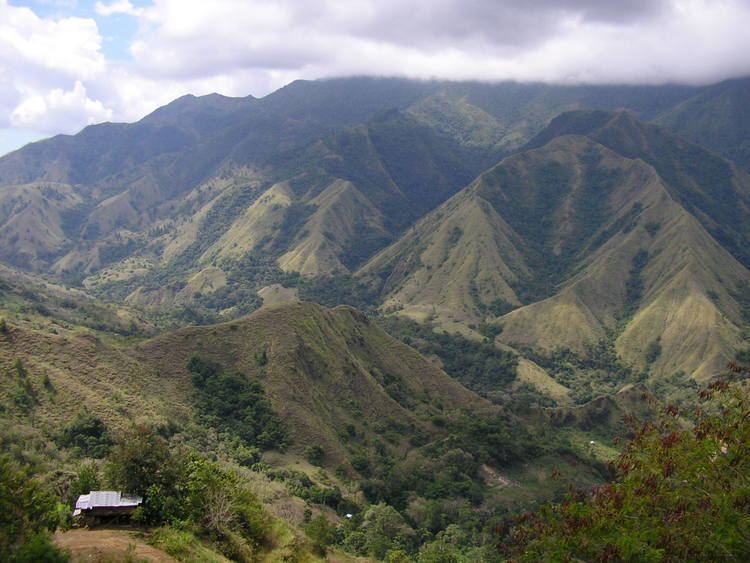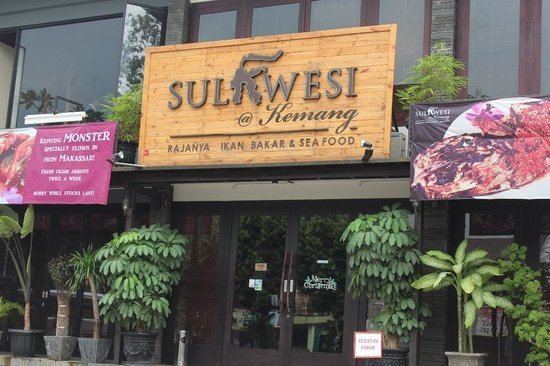Country Area 46,717.48 km2 Governor Golkar Party | Capital Population 8.035 million (2010) | |
 | ||
Colleges and Universities Hasanuddin University (Makassar), State University of Makassar (Makassar), Muhammadiyah University of Makassar | ||
Languages spoken Buginese, Makassarese | ||
Map of South Sulawesi
South Sulawesi (Indonesian: Sulawesi Selatan; Buginese: ᨔᨘᨒᨓᨙᨔᨗ ᨒᨕᨘᨈ ) is a province in the southern peninsula of Sulawesi. The Selayar Islands archipelago is also part of the province.
Contents
- Map of South Sulawesi
- South sulawesi trip
- Geography
- Administrative divisions
- Ethnic groups
- Language
- Religion
- History
- Economy
- Airports
- Ports
- Philosophy
- Traditional costume
- Traditional ship
- Traditional houses
- Traditional songs
- References

The 2010 census estimated the population as 8,032,551 which makes South Sulawesi the most populous province on the island (46% of the population of Sulawesi is in South Sulawesi), and the sixth most populous province in Indonesia.

South sulawesi trip
Geography

South Sulawesi is located at 4°20'S 120°15'E and covers an area of 45,764.53 square kilometres. The province is bordered by Central Sulawesi and West Sulawesi to the north, the Gulf of Bone and Southeast Sulawesi to the east, Makassar Strait to the west, and Flores Sea to the south.
Administrative divisions

Five years after independence, the government issued Law No. 21 of 1950, which became the basis of the legal establishment for the Sulawesi province. Ten years later, the government passed Law No. 47 of 1960 which endorsed the formation of the South/Southeast Sulawesi province. Four years after that, with Act No. 13 of 1964, the provinces of South Sulawesi and Southeast Sulawesi were separated.

Forty years later, the South Sulawesi government was split into two, with the regencies of Majene, Mamasa, Mamuju, North Mamuju, and Polewali Mandar were separated off into a new West Sulawesi province on 5 October 2004 under Act No. 26 of 2004.
The remaining South Sulawesi Province is divided into 21 regencies and three independent cities, listed below with their (provisional) populations as of the 2010 Census.
# The 2000 Census population for Palopo city is included in the figure for Luwu Regency.* The 2000 Census population for North Toraja Regency is included in the figure for Tana Toraja Regency, which was formed in 2008 following the publication of Commission President Yudhoyono, numbered R.68/Pres/12/2007 on 10 December 2007, regarding the expansion of the twelve original districts and cities.*** The 2000 Census population for East Luwu Regency is included in the figure for North Luwu Regency.Ethnic groups
South Sulawesi has a diverse range of ethnic groups. These are the main three:
Language
There are various languages and dialects spoken in South Sulawesi. Majority of them belongs to Malayo-Polynesian branch of Austronesian languages. Below is the list of major languages spoken in the province.
3,921,543 males and 4,111,008 females with 1,848,132 housing units with average of 4.34 people per unit versus national average of 3.86. Some 13.3 percent of the population was under the national poverty line.
Religion
The main religion in South Sulawesi is Islam at 89.62% (7,200,938). Other major religions include Protestantism 7.62% (612,751), Roman Catholicism 1.54% (124,255), Buddhism 0.24% (19,867), Hinduism 0.72% (58,393), and Confucianism 0.004% (367).
History
Sulawesi was first inhabited by humans about 30,000 years ago. The archaeological remains of the earliest inhabitants were discovered in caves near limestone hills around Maros, about 30 km northeast of Makassar, the capital of the South Sulawesi province. Peeble and flake stone tools have been collected from the river terraces in the valley of Walanae, among Soppeng and Sengkang, including the bones from giant pig and elephant species that are now extinct. Hand print paintings, estimated to be around 35,000 to 40,000 years old, have been found in the Pettakere cave, located 12 kilometres (7.5 mi) from the town of Maros and 30 kilometres (19 mi) from Makassar.
During the golden era of the spice trade, from the 15th to 19th centuries, South Sulawesi served as the gateway to the Maluku Islands.
At around the 14th century in South Sulawesi there were a number of small kingdoms, including two prominent ones, the Kingdom of Gowa near Makassar and the Bugis kingdom located in Bone. In 1530, the kingdom of Gowa began development and in the mid 16th century, Gowa become one of the most important trade centers in eastern Indonesia. In 1605, the King of Gowa embraced Islam and made the kingdom of Gowa Islamist and between the years 1608 and 1611, the Kingdom of Gowa conquered the kingdom of Bugis so that Islam could be spread to the regions of Makassar and Bone.
Dutch East India Company began operating in the region in the 15th century and saw the Kingdom of Gowa as an obstacle to its desire for control of the spice trade in this area. VOC later allied with the Bugis prince, Arung Palakka, who was living in exile after the fall of the Bugis. After a year-long battle, they defeated the kingdom of Gowa. And the king of Gowa, Sultan Hasanuddin was forced to sign a treaty which greatly reduced the power of Bungaya Gowa. Furthermore, Palakka became ruler in South Sulawesi.
A Bugis queen later emerged to lead the resistance against the Dutch, who were busy dealing with the Napoleonic Wars in Europe. Yet once past the Napoleonic Wars, the Dutch returned to South Sulawesi and eradicated the queen's rebellion. But resistance of the Bugis people against colonial rule continued until 1905. In 1905, the Dutch also managed to conquer Tana Toraja.
Before the proclamation of the Republic of Indonesia, South Sulawesi consisted of a number of independent kingdoms' territory and was inhabited by four ethnic groups namely the Bugis, Makassar, Mandar, and Toraja.
Economy
The Sulawesi economy grew 7.78 percent in 2008 and grew by 6.20 percent in 2009. Economic Growth in the First Quarter of 2010 reached 7.77 percent. The GDP in 2009 (ADHK) amounted to Rp 47.31 trillion and 99.90 Trillion (ADHB). There was a per capita income of USD 12.63 million in 2009.
Airports
Ports
Philosophy
Culture Siri 'Na Pacce is one cultural philosophy of the Bugis-Makassar Society which must be upheld. If one is a siri 'na pacce (not a person), then that person doesn't exceed the behavior of animals, because it has no sense of shame, self-esteem, and social concerns. The people of Bugis-Makassar, they teach morality in the form of advice about decency, prohibition, and the rights and obligations that dominate human action to preserve and defend himself and his honor. They have a very strong relationship with the view of Islam in terms of spirituality, where the strength of the soul can conquer the body. The core concept of siri 'na pacce covers all aspects of community life and is the identity of the Bugis-Makassar.
Traditional costume
Baju bodo is the traditional costume of the women. Baju bodo is rectangular and is usually short sleeved. According to customs, every color of the clothes worn by women shows the age or the dignity of the wearer. Clothing is often used for ceremonies such as weddings. But now, baju bodo is worn in other events such as dance competitions or to welcome guests.
Traditional ship
The pinisi or phinisi is a traditional Indonesian two-masted sailing ship. It was mainly built by the Konjo tribe, a sub-ethnic group but was, and still is used widely by the Buginese and Makassarese, mostly for inter-insular transportation, cargo, and fishing purposes within the Indonesian archipelago.
The hull of the ships looks similar to that of a dhow while the fore-and-aft rigging is similar to that of western schooners, although it might be more correctly termed to resemble a ketch, as the front mast is the larger. The large mainsails differ from western style gaff rigs though, as they often do not have a boom and the sail is not lowered with the gaff. Instead it is reefed towards the mast, much like a curtain, thus allowing the gaff to be used as deck crane in the harbor. The lower part of the mast itself may resemble a tripod or is made of two poles. Pinisi may be 20 to 35 meters long and can weigh up to 350 tons. The masts may be as high as 30 meters above the deck.
Traditional houses
South Sulawesi has three types of traditional houses. The most known are the Rumah Panggung (Balla'/Bola) from Bugis Makassar and the Tongkonan from Toraja.
Usually a good day or a month to build the house is determined by those who have the skill in that regard. Building the house is preceded by a ritual ceremony.
